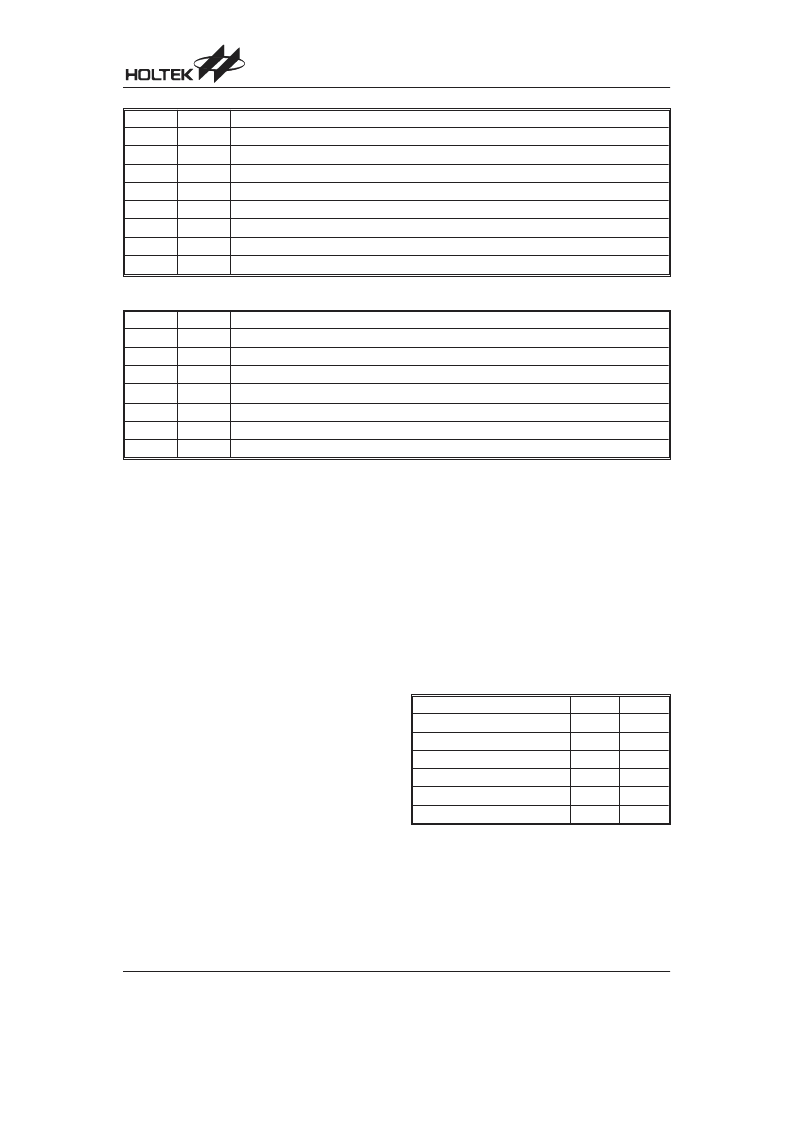- 您現(xiàn)在的位置:買賣IC網(wǎng) > PDF目錄385403 > HT82A832R (Holtek Semiconductor Inc.) Basic USB Phone OTP MCU PDF資料下載
參數(shù)資料
| 型號: | HT82A832R |
| 廠商: | Holtek Semiconductor Inc. |
| 英文描述: | Basic USB Phone OTP MCU |
| 中文描述: | 檢察官辦公室的基本USB電話單片機 |
| 文件頁數(shù): | 11/51頁 |
| 文件大?。?/td> | 345K |
| 代理商: | HT82A832R |
第1頁第2頁第3頁第4頁第5頁第6頁第7頁第8頁第9頁第10頁當前第11頁第12頁第13頁第14頁第15頁第16頁第17頁第18頁第19頁第20頁第21頁第22頁第23頁第24頁第25頁第26頁第27頁第28頁第29頁第30頁第31頁第32頁第33頁第34頁第35頁第36頁第37頁第38頁第39頁第40頁第41頁第42頁第43頁第44頁第45頁第46頁第47頁第48頁第49頁第50頁第51頁

HT82A832R
Rev. 1.00
11
July 18, 2006
related interrupt request flag (T1F) will be reset and the
EMI bit cleared to disable further interrupts.
The play interrupt is initialized by setting the play
interrupt request flag (bit 4 of INTC1), caused by a play
datavalid.Whentheinterruptisenabled,thestackisnot
full and the PLAYF is set, a subroutine call to location
10H will occur. The related interrupt request flag
(PLAYF) will be reset and the EMI bit cleared to disable
further interrupts. If PLAY_MODE (bit 3 of MODE_CTRL
register) is set to 1 , the play interrupt frequency will
change to 8KHz, otherwise the interrupt frequency is
48kHz.
The serial interface interrupt is indicated by the interrupt
flag (SIF; bit 5 of INTC1), that is generated by the
reception or transfer of a complete 8-bits of data
between the HT82A832R and the external device. The
serial interface interrupt is controlled by setting the
Serial interface interrupt control bit (ESII; bit 1 of
INTC1). After the interrupt is enabled (by setting SBEN;
bit4ofSBCR),andthestackisnotfullandtheSIFisset,
a subroutine call to location 14H occurs.
The record interrupt is initialized by setting the record
interrupt request flag (bit 6 of INTC1), caused by a
record data valid. When the interrupt is enabled, the
stack is not full and RECF is set, a subroutine call to
location18Hwilloccur.Therelatedinterruptrequestflag
(RECF) will be reset and the EMI bit cleared to disable
further interrupts. If ADC powered down (AD_ENB =1)
or USB clock disabled (USBCKEN=0), the record
interrupt will be disabled.
During the execution of an interrupt subroutine, other
interrupt acknowledge signals are held until the RETI
instruction is executed or the EMI bit and the related
interrupt control bit are set to 1 (if the stack is not full). To
return from the interrupt subroutine, RET or RETI
may be invoked. RETI will set the EMI bit to enable an
interrupt service, but RET will not.
Interrupts, occurring in the interval between the rising
edges of two consecutive T2 pulses, will be serviced on
the latter of the two T2 pulses, if the corresponding
interrupts are enabled. In the case of simultaneous
requests the following table shows the priority that is
applied.ThesecanbemaskedbyresettingtheEMIbit.
Interrupt Source
Priority
Vector
USB interrupt
1
04H
Timer/Event Counter 0 overflow
2
08H
Timer/Event Counter 1 overflow
3
0CH
Play Interrupt
4
10H
Serial Interface Interrupt
5
14H
Record Interrupt
6
18H
It is recommended that a program does not use the
CALL subroutine
Interrupts often occur in an unpredictable manner or
need to be serviced immediately in some applications. If
only one stack is left and enabling the interrupt is not
well controlled, the original control sequence will be
within the interrupt subroutine.
damaged once the
subroutine.
CALL
operates in the interrupt
Bit No.
Label
Function
0
EMI
Controls the master (global) interrupt (1=enable; 0=disable)
1
EUI
Controls the USB interrupt (1=enable; 0=disable)
2
ET0I
Controls the Timer/Event Counter 0 interrupt (1=enable; 0=disable)
3
ET1I
Controls the Timer/Event Counter 1 interrupt (1=enable; 0=disable)
4
USBF
USB interrupt request flag (1=active; 0=inactive)
5
T0F
Internal Timer/Event Counter 0 request flag (1=active; 0=inactive)
6
T1F
Internal Timer/Event Counter 1 request flag (1=active; 0=inactive)
7
Unused bit, read as 0
INTC0 (0BH) Register
Bit No.
Label
Function
0
EPLAYI
Play interrupt (1=enable; 0=disable)
1
ESII
Control Serial interface interrupt (1=enable; 0=disable)
2
RECI
Record interrupt (1=enable; 0=disable)
3, 7
Unused bit, read as 0
4
PLAYF
Play interrupt request flag (1=active; 0=inactive)
5
SIF
Serial interface interrupt request flag (1=active; 0=inactive)
6
RECF
Record interrupt request flag (1=active; 0=inactive)
INTC1 (1EH) Register
相關PDF資料 |
PDF描述 |
|---|---|
| HT82A850R | Audio MCU |
| HT82A851R | USB Audio MCU |
| HT82J30A | 16 Channel A/D MCU with SPI Interface |
| HT82J30R | 16 Channel A/D MCU with SPI Interface |
| HT82J927A | USB Gamepad |
相關代理商/技術參數(shù) |
參數(shù)描述 |
|---|---|
| HT82A832R_07 | 制造商:HOLTEK 制造商全稱:Holtek Semiconductor Inc 功能描述:USB Audio MCU |
| HT82A834R | 制造商:HOLTEK 制造商全稱:Holtek Semiconductor Inc 功能描述:USB Audio MCU |
| HT82A836R | 制造商:HOLTEK 制造商全稱:Holtek Semiconductor Inc 功能描述:USB Audio MCU |
| HT82A850R | 制造商:HOLTEK 制造商全稱:Holtek Semiconductor Inc 功能描述:Audio MCU |
| HT82A851R | 制造商:HOLTEK 制造商全稱:Holtek Semiconductor Inc 功能描述:USB Audio MCU |
發(fā)布緊急采購,3分鐘左右您將得到回復。